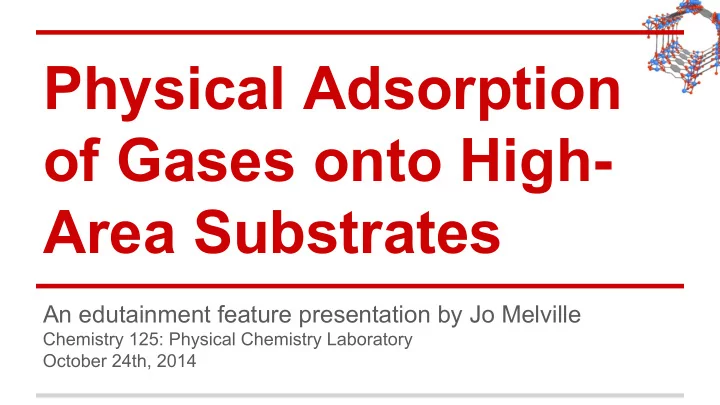

Physical Adsorption of Gases onto High- Area Substrates An edutainment feature presentation by Jo Melville Chemistry 125: Physical Chemistry Laboratory October 24th, 2014
Why Gas Sorption? ● Atmospheric CO 2 up 25% in past 50 years ● Global temperatures up 0.8 ℃ in past 50 years ● Gas storage could make greener fuels economically/energetically viable ● Gas capture could scrub existing greenhouse gases from the atmosphere Hansen, J., et al. (2006) "Global temperature change". Proc. Natl. Acad. Sci. 103: 14288-14293 Chu, S. Science 2009, 325, 1599. Granite, E. J.; Pennline, H. W. Ind. Eng. Chem. Res. 2002, 41, 5470.
Why Gas Sorption? ● Two key elements: ○ Gas Storage ■ Stable, high-density ways to store gases ■ Often for gaseous fuel sources (CH 4 , H 2 , etc.) ■ Requires controllable adsorption/desorption ○ Gas Capture ■ Rapid, high-density ways to sequester gases from air, or scrub waste products ■ Often for greenhouse gases (CO 2 , etc.) ■ Primarily requires strong adsorption only Capture of Carbon Dioxide from Air and Flue Gas in the Alkylamine-Appended Metal–Organic Framework mmen-Mg2(dobpdc) Thomas M. McDonald, Woo Ram Lee, Jarad A. Mason, Brian M. Wiers, Chang Seop Hong, and Jeffrey R. Long. Journal of the American Chemical Society 2012 134 (16), 7056-7065
Experimental Goals ● Test uptake of N 2 gas on silica as proof of concept: ○ Construct adsorption isotherm ■ Presence of “steps” allow for rapid modulation of gas sorption through small changes in pressure ○ Measure density of gas storage: ■ Order-of-magnitude estimate gives a baseline for energy densities of adsorbed gases ○ Measure enthalpy of adsorption: ■ Provides reference value for CO 2 sequestration, determines viability of gas storage for energy use
Experimental Design ● Silica sample placed under vacuum ● Calibration with inert He gas through use of gas bulbs ● N 2 gas introduced, pressure drop measured, process repeated until pressure drop is zero ● Plot relative pressure p/p° vs. cumulative volume adsorbed
Experimental Theory ● Langmuir models single monolayer formation as molecules adsorb to a surface ● BET models multiple layers as molecules adsorb onto already- adsorbed molecules in discrete monolayers BET isotherm model. ○ Breaks down for too θ: number of monolayers few or too many layers x: relative pressure (p/p°) (.05<(p/p°)<0.3) c: temperature-dependant constant http://www.cchem.berkeley.edu/molsim/teaching/fall2011/CCS/Group7/images/structure/models.jpg A Model for Multilayer Adsorption of Small Molecules in Microporous Materials. Janina Milewska-Duda,*,†, Jan T. Duda,*,‡, Grzegorz Jodłowski,† and, and Mirosław Kwiatkowski. Langmuir 2000 16 (18), 7294-7303
Data: Silica Gel Isotherm ● Type II Isotherm ○ 0<x<0.1: monolayer formation ○ 0.1<x<0.6: multiple layer formation ○ 0.6<x<0.8: N 2 (l) condensation ● Multiple isotherms account for different methods of calibrating the bulbs with mercury
Data: Linearization of Silica Gel Isotherm ● Plotting x vs. x/(v(1-x)) linearizes the isotherm ● Most linear 0.05<x<0.3
Data: Linearization of Silica Gel Isotherm ● Focus on x= [0.05, 0.3] to maximize fit ● Temperature dependence and monolayer volume can be derived from slope/intercept of fit
Results: Surface Area, Heat of Adsorption Monolayer volume Surface area Heat of adsorption (ν m ) (cm 3 ) (σ) (m 2 /g) (q ads ) (J/mol) 3-Term 64(2) 270(10) 9200(600) 2-Term 42(1) 180(0) 9200(600) Lit: Langmuir surface area = 592 m 2 /g ● ○ Langmuir model does not account for formation of multiple layers Values are orders of magnitude higher than competing chemisorption methods (σ=0.3350 m 2 /g for H 2 gas on a ● Ru metal sponge) ○ Order-of-magnitude energy density of this adsorbed gas (~0.56 MJ/L) is roughly an order of magnitude higher than gaseous H 2 , though an order of magnitude lower than compressed liquid H 2 ● q ads unfortunately an order of magnitude below comparable adsorption energies for zeolites (~55 kJ/mol) http://www.azom.com/article.aspx?ArticleID=1114 College of the Desert, “Module 1, Hydrogen Properties”, Revision 0, December 2001 Hydrogen Properties. Retrieved 2014-06-08. Peereboom, Lars. Adsorption of Bio-renewable Substrates on Supported Metal Catalyst in Water. pp. 30 Adsorption of CO2 on Zeolites at Moderate Temperatures. Ranjani V. Siriwardane,*, Ming-Shing Shen, and, Edward P. Fisher, and James Losch. Energy & Fuels 2005 19 (3), 1153-1159
A Proposed Method for Gas Sorption ● Repeating array of organic “linkers” ● Periodic metal binding sites ● Crystal framework creates micropores for gas storage ● “Folding” of structure could create multiple isotherm “steps” for easy sorption/desorption
A Proposed Method for Gas Sorption ● M etal ● E ntangled ● L igand ● V ery ● I deal for ● L ocalizing ● L ots of ● E nergy or, for short: ● J metal ● O rganicframework http://1.bp.blogspot.com/_vfImvyorvjQ/S66l4_2V8AI/AAAAAAAADJ4/EUM0153hLaI/s1600/bath+mof+figforpress1.jpg http://www.sigmaaldrich.com/content/dam/sigma-aldrich/materials-science/learning-center/mof/mof-header.jpg
Conclusions ● Validation of BET theory as an improvement on Langmuir theory ● Order-of-magnitude estimates suggest commercially-viable energy densities for hydrogen storage are plausible ● Greater surface area/porosities are necessary for carbon capture/sequestration ● Next steps: ○ adsorption of different gases (H 2 , CH 4 ) ○ MELVILLE/JO synthesis to maximize substrate surface area
Questions? ● Thanks to: ○ The Melville Group ○ Jo Melville ○ Jo Melville ○ Jonathan “Jo” Melville ○ Jonathan F. Melville ○ Melville, J. ○ J. Melville ○ Jonathan “Herman” Melville ○ Jonathan “Ishmael” Melville
Recommend
More recommend